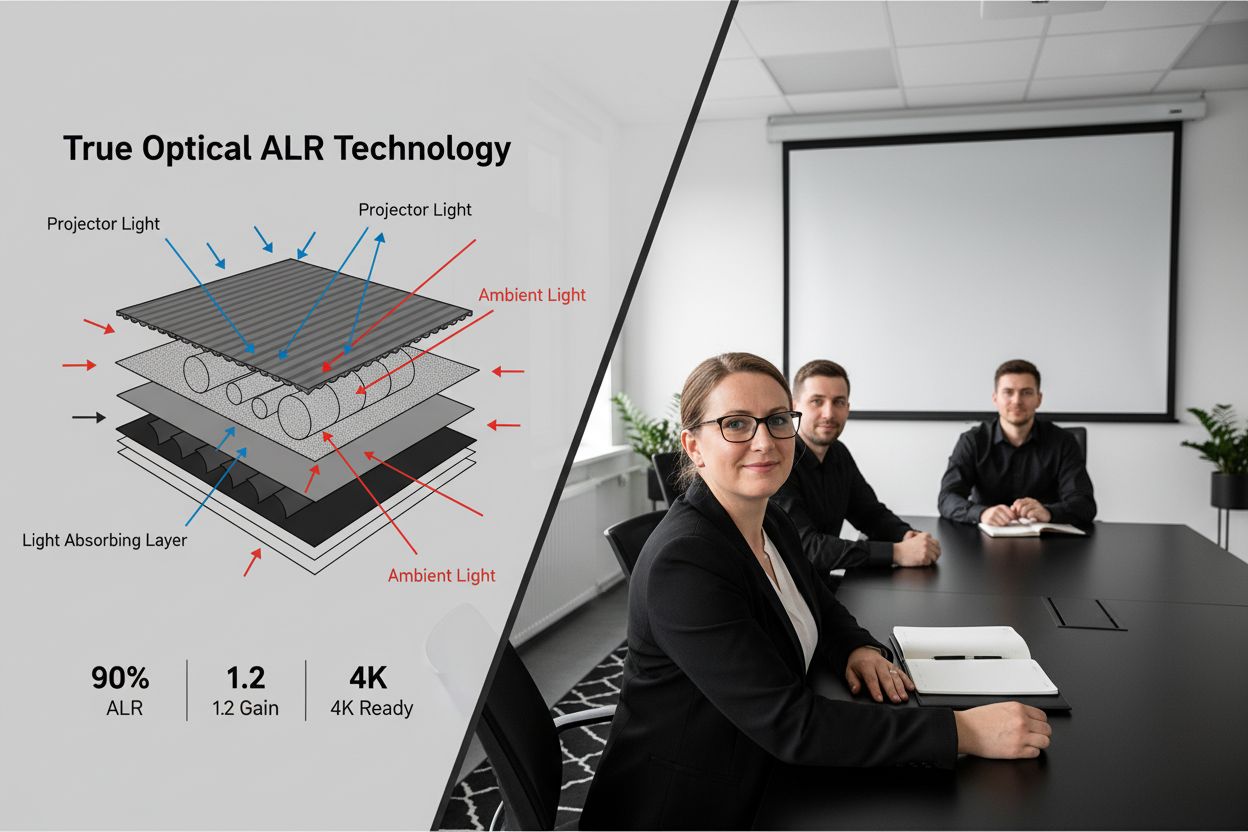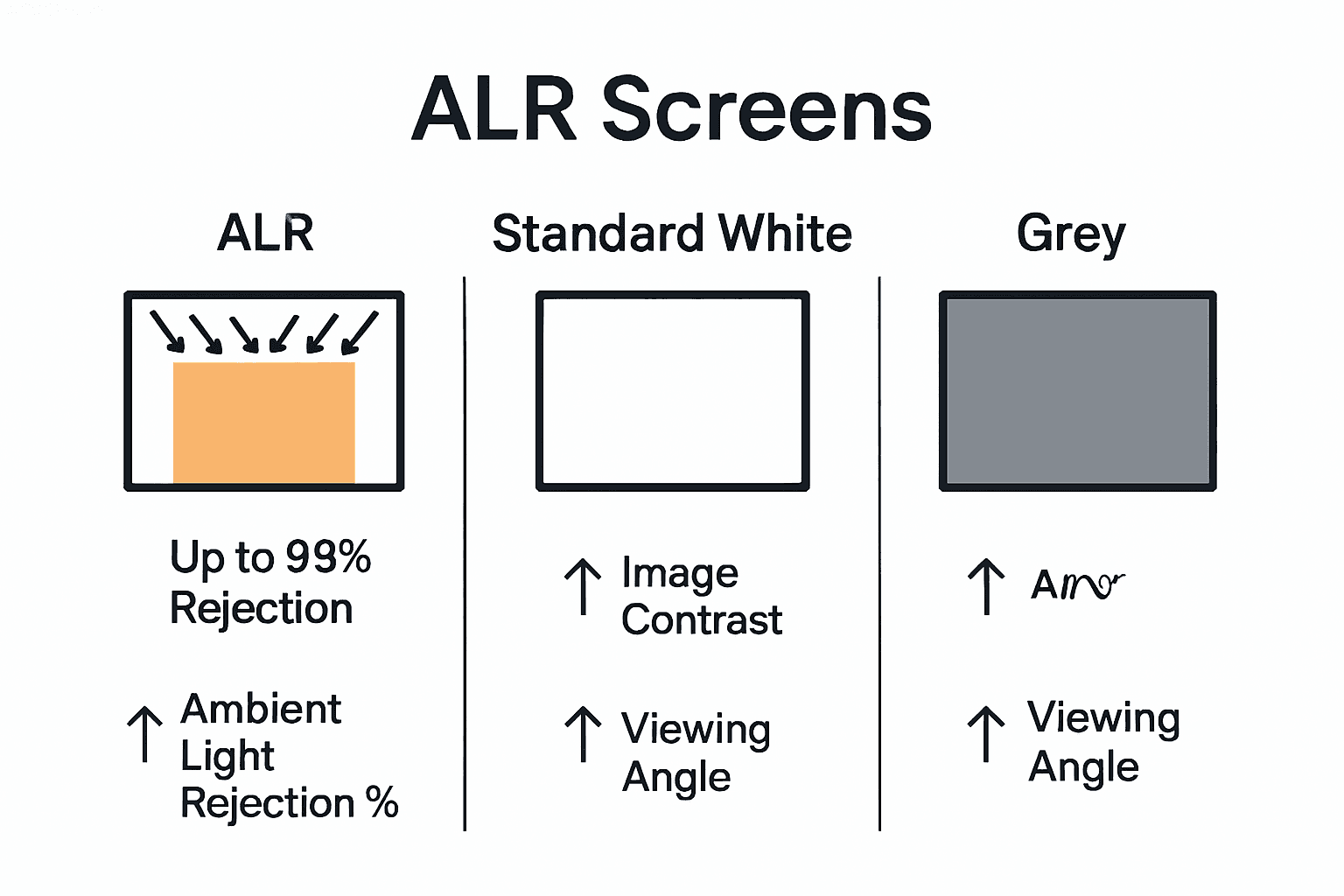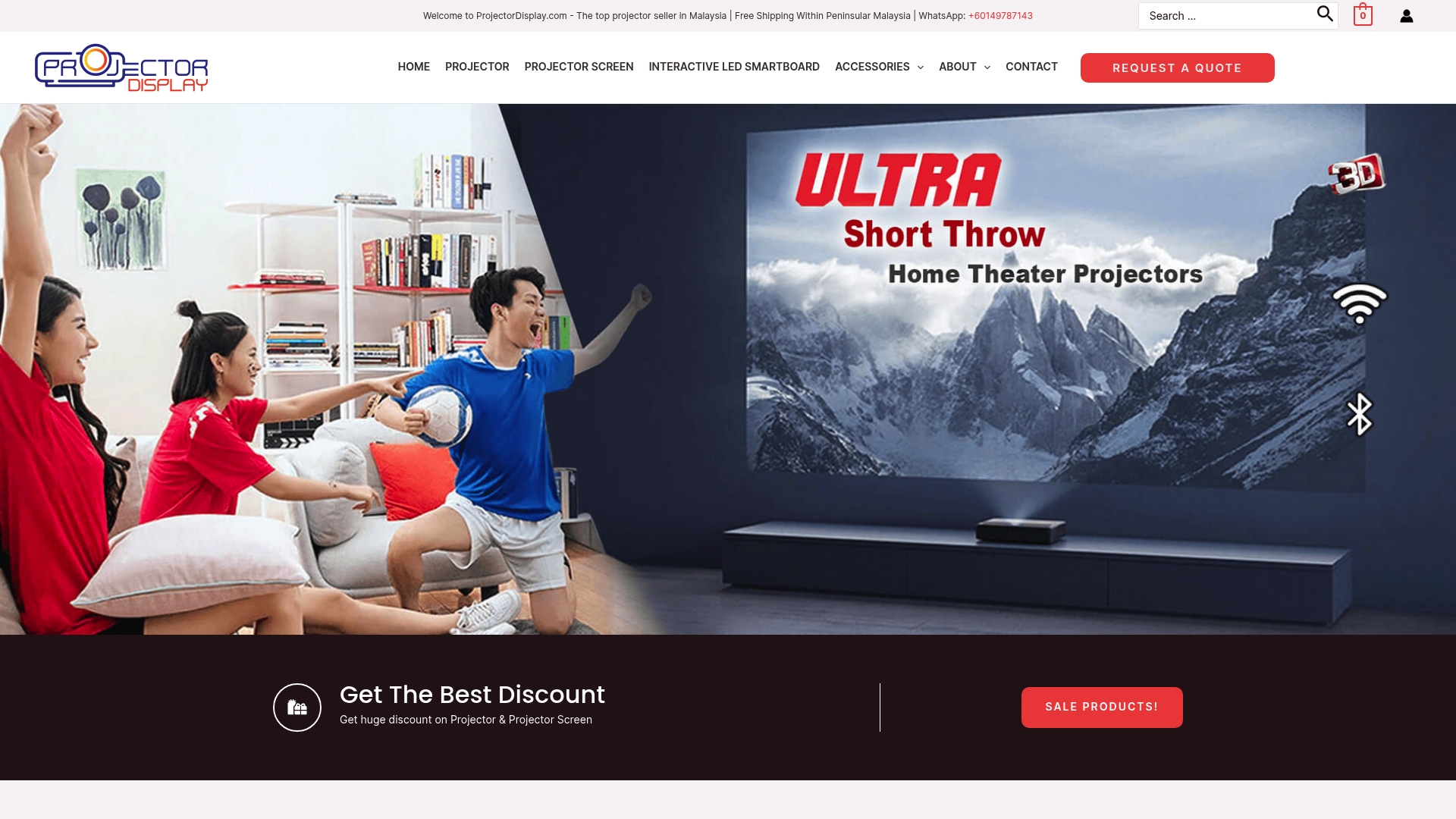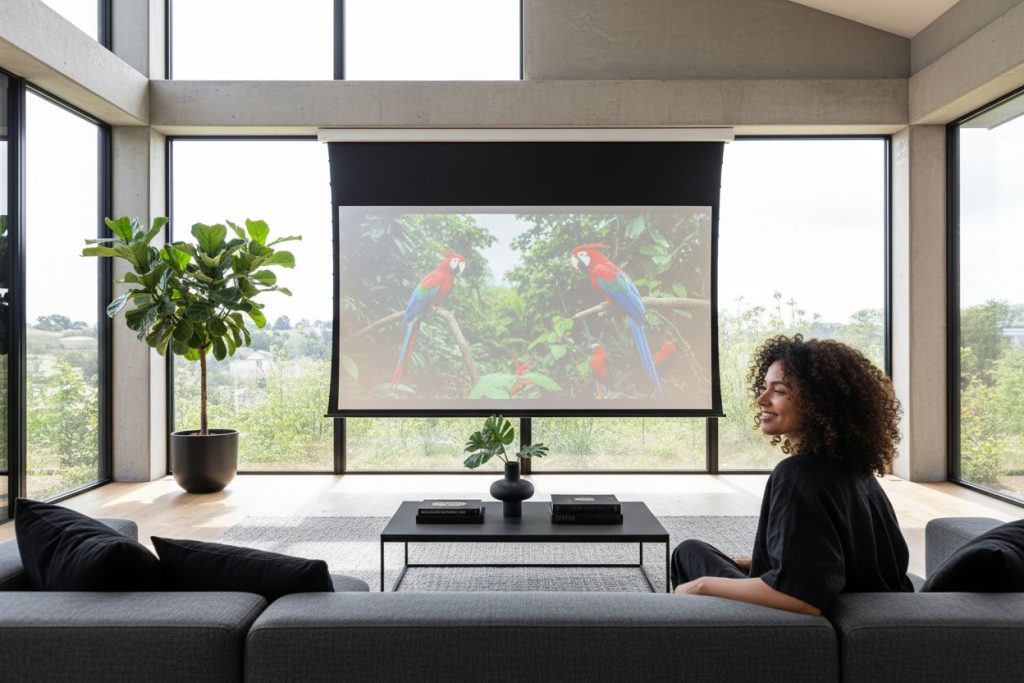Did you know that up to 99 percent of unwanted light can be blocked by the latest Ambient Light Rejecting (ALR) screens? For anyone frustrated by washed-out projector images in bright rooms, this technology is changing what's possible. ALR screens use advanced materials to reflect only the projector light you want, meaning even sunny windows or overhead lights no longer ruin your viewing experience. Get ready to discover how these screens can bring vibrant, crystal-clear images to any space.
Key Takeaways
| Point | Details |
|---|---|
| ALR Screen Functionality | Ambient Light Rejecting screens selectively reflect projector light while minimizing interference from ambient light, ensuring vibrant and clear images. |
| Types of ALR Screens | There are various ALR screen types, including Contrast-Based and True Optical, each tailored for specific environments and lighting conditions. |
| Installation & Maintenance | Proper installation is critical for ALR screens to maintain their performance, and careful cleaning is required to preserve their optical properties. |
| Comparison with Standard Screens | ALR screens significantly outperform traditional screens in bright conditions by actively managing light and enhancing contrast, leading to superior image quality. |
Table of Contents
- Defining Ambient Light Rejecting Screens
- Types And Technologies Of ALR Screens
- How ALR Screens Work In Bright Rooms
- Real-World Applications And Use Cases
- Cost, Installation, And Maintenance Factors
- Comparisons With Standard And Grey Screens
Defining Ambient Light Rejecting Screens
Ever struggled with projector image quality in bright rooms? Ambient Light Rejecting (ALR) screens are engineering marvels designed to solve this frustrating problem. According to BenQ, these specialized projection screens are engineered to deliver brighter, clearer images by selectively managing light in your environment.
Here's how ALR screens work their magic:
- Selective Light Reflection: These screens use multi-layer materials that strategically reflect projector light while diverting ambient light away from viewers
- Enhanced Contrast: By minimizing unwanted light interference, ALR screens dramatically improve image clarity and color saturation
- Versatile Performance: Perfect for spaces with challenging lighting conditions like living rooms, classrooms, and conference areas
As research from Commercial Electronics Pro highlights, ALR screens achieve their remarkable performance through sophisticated optical engineering. The screen's specialized surface acts like a precision light filter, capturing your projector's intended light while effectively rejecting stray illumination from windows, overhead lights, and other potential image-degrading sources.
Whether you're setting up a home theater, classroom presentation space, or professional conference room, Ambient Light Rejecting screens represent a game-changing solution for consistently stunning visual experiences. No more washed-out images or compromised presentations – just crystal-clear, vibrant displays that perform brilliantly in any lighting condition.
Types and Technologies of ALR Screens
Ambient Light Rejecting (ALR) screens aren't a one-size-fits-all solution. In fact, they come in fascinating variations engineered to tackle different projection challenges. According to Legrand AV, there are primarily two fundamental technologies transforming how we experience projected images.
Contrast-Based ALR Screens
- Gray Surface Technology: These screens absorb ambient light, blocking up to 80% of external illumination
- Improved Image Depth: By reducing light scatter, these screens enhance perceived image contrast
- Cost-Effective Option: Generally more affordable compared to advanced optical technologies
True Optical ALR Screens
- Precision Engineering: Utilize microscopic saw-tooth and lens layers
- Extreme Light Rejection: Can reject up to 99% of ambient light from specific angles
- High-Luminosity Performance: Deliver remarkably vivid and crisp images
Research from Valerion further reveals two specialized screen technologies: Fresnel ALR and Lenticular UST screens. Fresnel screens offer high gain with up to 90% ambient light rejection but come with narrower viewing angles. Lenticular UST screens, designed specifically for ultra-short throw projectors, feature microstructured surfaces that effectively direct projector light while minimizing ambient light interference.
Choosing the right ALR screen depends on your specific environment, projector type, and desired visual performance. Each technology offers unique advantages, ensuring there's a perfect screen solution for virtually any projection scenario.

Here's a comparison of the primary ALR screen types and technologies:
| Screen Type | Light Rejection | Viewing Angle | Typical Applications |
|---|---|---|---|
| Contrast-Based ALR | Up to 80% | Wide | Home entertainment Classrooms |
| True Optical ALR | Up to 99% from angles | Moderate Narrow |
Conference rooms Bright spaces |
| Fresnel ALR | Up to 90% | Narrow | Fixed installations High-gain use |
| Lenticular UST ALR | Optimized for UST | Wide | Ultra-short throw projectors |
How ALR Screens Work in Bright Rooms
Imagine a projection screen that can magically transform bright, challenging environments into perfect viewing spaces. According to Projector Screen New Zealand, ALR screens leverage a brilliant optical principle called angular reflectivity to achieve this seemingly impossible feat.
The Science of Light Redirection
- Precise Angle Reflection: Projector light is reflected directly toward viewers at a mirror-opposite angle
- Ambient Light Rejection: External light hitting from different directions gets reflected away
- Preservation of Image Quality: Maintains crisp, vibrant visuals even in well-lit rooms
Research from Draper Inc. reveals the technical magic behind this technology. Specular reflection elements and dark gray surfaces work together to absorb stray ambient light while preferentially reflecting projector light. This intricate design increases screen gain and contrast, though it does narrow the optimal viewing angles.
In practical terms, this means your projection experience transforms dramatically. Sunlight streaming through windows, overhead fluorescent lights, or bright room lamps no longer wash out your image. Instead, the ALR screen acts like a sophisticated light filter, ensuring that only the intended projector light reaches your eyes. Whether you're giving a presentation in a bright conference room or enjoying a movie in a living room with large windows, ALR screens deliver consistently stunning visual performance.
Real-World Applications and Use Cases
Ambient Light Rejecting (ALR) screens aren't just a technological novelty – they're practical solutions transforming visual experiences across multiple environments. According to Legrand AV, specialized True Optical ALR screens like the Parallax series can handle incredibly challenging lighting conditions, offering up to 96% ambient light rejection with impressive versatility.
Diverse Application Environments
- Home Entertainment: Perfect for living rooms with large windows or bright spaces
- Professional Settings: Ideal for conference rooms with variable lighting conditions
- Educational Spaces: Excellent for classrooms and lecture halls with overhead illumination
- Collaborative Workspaces: Ensures clear presentations regardless of ambient light
Research from AV Related highlights the nuanced differences between screen technologies. While standard ALR screens work brilliantly in general bright environments, Ceiling Light Rejecting (CLR) screens are specifically engineered for overhead lighting scenarios like offices and classrooms.
Practical scenarios demonstrate ALR screens' transformative potential. Imagine a university library where students can view crystal-clear presentations without closing blinds, or a corporate boardroom where natural light doesn't compromise visual quality. From home theaters to professional training rooms, ALR screens deliver consistent, high-quality visual experiences that adapt seamlessly to challenging lighting conditions.
Cost, Installation, and Maintenance Factors
Investing in an Ambient Light Rejecting (ALR) screen involves more than just selecting a product – it's about understanding the nuanced factors of cost, installation, and long-term performance. According to AV Related, these specialized screens typically command a premium price point compared to traditional projection surfaces.
Cost Considerations
- Initial Investment: ALR and CLR screens are more expensive than standard projection screens
- Technology Premium: Specialized surface technologies drive higher pricing
- Long-Term Value: Improved image quality can justify the additional expense
- Variation by Type: Fresnel and optical ALR screens have different price ranges
Research from Valerion highlights critical installation insights for Fresnel ALR screens. These sophisticated screens demand precise mounting due to their structured layered fabric and fixed-frame design. Improper installation can lead to uneven brightness or distracting "hot-spotting" effects that compromise visual performance.
Maintenance is another crucial factor. While protective coatings on modern ALR screens facilitate easier cleaning, users must handle these specialized surfaces with care. Avoid abrasive materials, direct contact with cleaning solutions, and excessive pressure. Professional installation is often recommended to ensure optimal positioning and prevent potential damage to the screen's delicate optical layers. Think of an ALR screen like a high-performance piece of technology – it requires thoughtful handling to maintain its remarkable light-rejecting capabilities.
Comparisons With Standard and Grey Screens
Not all projection screens are created equal. According to Legrand AV, Ambient Light Rejecting (ALR) screens represent a quantum leap in projection technology compared to traditional white or grey screens.
Performance Differences
- Ambient Light Control: ALR screens actively manage external light, unlike passive standard screens
- Contrast Enhancement: Dramatically improved image depth and color saturation
- Viewing Experience: Maintains image quality in challenging lighting environments
- Directional Reflection: Precise light management not possible with standard surfaces
Screen Technology Breakdown
- Standard White Screens: Reflect all light uniformly, washing out images in bright rooms
- Grey Screens: Absorb some ambient light, offering marginal improvement
- ALR Screens: Strategically reflect projector light while rejecting external illumination
Traditional grey screens attempt to reduce ambient light by absorbing some external illumination. However, they fundamentally lack the sophisticated directional reflection control of ALR technologies. Think of it like comparing a basic umbrella to a high-tech weather shield – both offer protection, but one does significantly more with advanced engineering. ALR screens don't just reduce light interference; they actively redirect and manage light waves to preserve image integrity, delivering a viewing experience that standard screens simply cannot match.

Upgrade Your Viewing Experience with ALR Screens
Tired of washed-out images and frustrating glare ruining your projector setup? If you've just learned how Ambient Light Rejecting screens work and why ordinary screens fall short in bright rooms, now is the ideal time to see the difference for yourself. Discover our full range of specially engineered projector screens designed to tackle Malaysia's sunlight and busy, well-lit spaces.

Don't let poor visuals hold back your home theater, classroom, or business presentations. Visit ProjectorDisplay.com and choose from advanced ALR projection solutions trusted by individuals and organizations across the country. Find your perfect screen setup and enjoy fast shipping and expert support when you order today.
Frequently Asked Questions
What are Ambient Light Rejecting screens?
Ambient Light Rejecting (ALR) screens are specialized projection screens designed to enhance image quality in bright environments by selectively reflecting projector light while minimizing interference from ambient light.
How do ALR screens improve image quality in bright rooms?
ALR screens utilize advanced optical technology to reflect light from projectors directly toward viewers and reject light coming from other directions. This results in improved contrast, clarity, and color saturation, even in well-lit spaces.
What are the main types of ALR screens?
There are two primary types of ALR screens: Contrast-Based ALR screens, typically featuring a gray surface to absorb ambient light, and True Optical ALR screens, which use precision engineering for extreme light rejection. Additionally, Fresnel and Lenticular UST screens cater to specific projection needs.
How do ALR screens compare to standard white and gray screens?
Unlike standard white screens that wash out images in bright conditions, ALR screens actively manage ambient light for a superior viewing experience. Gray screens can reduce some ambient light but lack the directional light control provided by ALR screens, resulting in less effective image preservation.
Recommended
- Understanding Projector Screen Materials for Home and Business – Projector Display
- 7 Best Projector Screens for Home Theater Enthusiasts – Projector Display
- 7 Types of Projection Screens You Need to Know – Projector Display
- Projector Screen Size Guide 2025: Perfect Fit for Malaysian Needs – Projector Display

